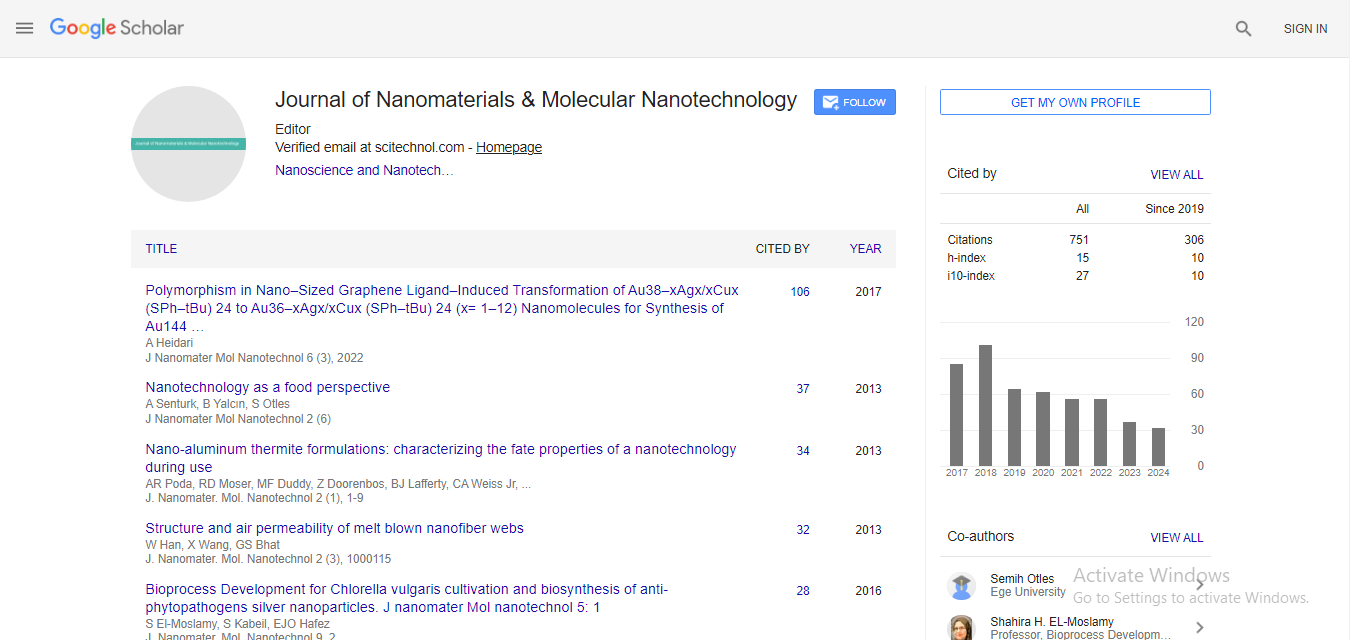Innovative functional tungsten disulfide (WS2) inorganic nanotubes (f-INTS-WS2): novel nontoxic nanoscale inorganic polymer-composite inorganic nanofillers
Jean Paul Lellouche
Bar Ilan University, Israel
: J Nanomater Mol Nanotechnol
Abstract
Statement of the problem: Tungsten disulfide nanotubes (INTs-WS2) and fullerene-like nanoparticles (IFs-WS2) are extremely hydrophobic and chemically inert inorganic nanomaterials, which quite strongly limits their usefulness in numerous mechanical hardness and tribology-relating research developments and subsequent industrial end-applications. Thus, the covalent attachment of any kind of functional organic and/or biology-relating species remains a quite critical developmental step towards highly innovative high-performance nanomaterials and multiphase composites in the field of essential interfacial versatile chemistries. Methodology & Theoretical Orientation: In this context of highly challenging functionalization issue of these chemically inert hydrophobic nanomaterials, an innovative method of surface functionalization (versatile polycarboxylate – polyCOOH shell formation) of multi-walled inorganic nanotubes (INTs-WS2) and fullerene-like (IFs-WS2) nanoparticles has been successfully developed. This covalent functionalization method makes use of highly electrophilic and reactive iminium salts (Vilsmeier-Haack (VH) complexes) to enable the introduction of a chemically versatile polyacidic (polyCOOH) shell onto the surface of VH-treated inorganic nanomaterials. Moreover, a significant statistical design of experiments (DoE) method has been also involved for global optimization of this multi-parametric polycarboxylation shell generation. Findings: This INTs-nanotube sidewall polyCOOH-enabling functionalization showed extreme COOH-based chemical versatility for innovative-targeted interfacial chemistries. It enabled the effective fabrication of a wide range of covalent WS2-INTs surface modifications (polyNH2, polyOH, polySH) via (i) polyCOOH chemical activation (EDC, CDI) and (ii) 2nd step covalent nucleophilic substitutions by short ï·-aminated ligands H2N-linker-X (X outer surface functionality). Conclusion & Significance: Resulting fully characterized functional INTs-WS2 (f-INTs-WS2) have a quite wide potential for use as novel functional nanoscale fillers towards new mechanically strengthened and/or conductive composite polymeric matrices (case of hybrid polythiophene-decorated f-INTs-WS2 nanocomposites, Figure 1). Corresponding novel functional nanomaterials/ nanoscale fillers have been also shown to be non-toxic in preliminary toxicity studies, which opens a wide R&D route/progress for relating end-user applications (cellular toxic CNTs nanofillers replacement for example). Recent Publications 1. Raichman D, Strawser D and Lellouche J P (2014) Design of Experiments: optimizing the polycarboxylation/ functionalization of tungsten disulfide nanotubes. Inorganics. 2(3):455-467. 2. Raichman D, Strawser D, Lellouche J P (2015) Covalent functionalization/polycarboxylation of tungsten disulfide inorganic nanotubes (INTs-WS2). Nano Research. 8(5):1454-1463. 3. Raichman D, Ben Shabat Binyamini R and Lellouche J P (2016) A new polythiophene-driven coating method on inorganic INT/IF-WS2 nanomaterial surface. RSC Advances. 6(6):4490-4504. 4. Ben Ishay et al. (2016) Multiple functionalization of tungsten disulfide inorganic nanotubes by covalently grafted conductive polythiophenes. RSC Advances. 6(92):89585-89598. 5. Sade H and Lellouche J P (2016) Functionalization of WS2 nanotubes with a conformal humin-like shell. Adv. Mater. Interfaces. 3:1-10
Biography
Jean-Paul Lellouche leads a laboratory dedicated to Nano-biotechnology and Polymer Science. His current R&D activities include “R&D developments in the materials science field interfacing with nano-biotechnology, i.e., conducting functional polymers; chemically modified hard nanoscale fillers; UV-photo-reactive nano(micro)particles [surface nano(micro)structuration of polymeric coatings, hybrid metallic catalytic particles]; antibacterial organic/inorganic NPs and coatings and; innovative surface modifications of iron oxide (magnetite/maghemite) NPs towards gene silencing (siRNA/microRNA in vitro/in vivo delivery) and anti-parasitic bio-activity”. Recently, he deeply focused on and elaborated various innovative organic chemistry-based methodologies for the development of effective covalent versatile interfacial chemistries towards chemically tailored non-toxic mechanically hard functional inorganic: Tungsten disulfide nanotubes and; tribology-effective fullerene-like tungsten disulfide nanoparticles. lellouj@biu.ac.il
 Spanish
Spanish  Chinese
Chinese  Russian
Russian  German
German  French
French  Japanese
Japanese  Portuguese
Portuguese  Hindi
Hindi 



